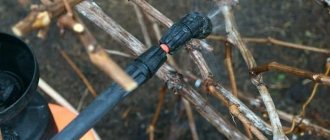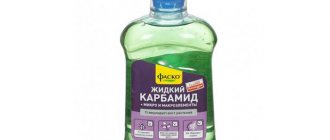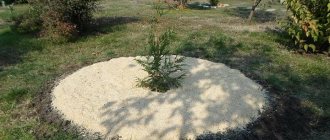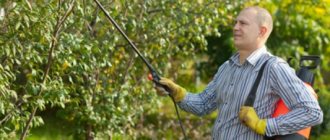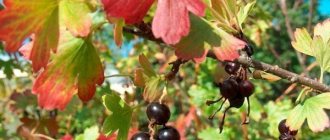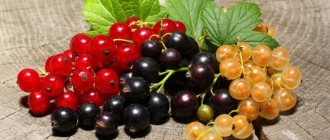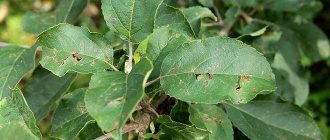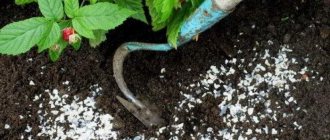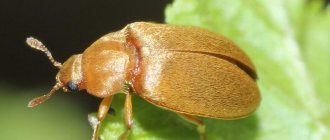Why do you need to process and spray grapes in spring?
It is easier to prevent any problem than to deal with it later. Therefore, it is recommended to strictly follow the schedule of preventive treatments for grapes in spring and summer, so that in the future the plant does not suffer from the diseases and pests discussed below.
Grape diseases
The following fungal diseases can affect the grapevine:
- Oidium (powdery mildew, white spots)
- Mildew (downy mildew) is the most common and harmful disease of grapes.
- Anthracnose - brown and brown spots appear on the vine.
- Phomopsis (excoriosis, black spot, dry sleeve).
- Gray rot - affects the vine, does not affect only perennial wood, destroys most of the crop.
- Black and white rot.
- Rubella.
When affected by fungal diseases, abnormal spots and growths of different colors and sizes appear on the vine.
Watch the video! Dangerous grape diseases and how to deal with them
Pests
The following pests most often attack grapes:
- Phylloxera (grape root aphid).
- Mites (spider mites, European red mites, felt mites, etc.).
- Leaf rollers (biennial, grape, grape, etc.).
- Thrips.
- Cicadas.
- Wasps.
- Slugs and snails.
Watch the video! Grape pests and how to deal with them
Disease Prevention
By following a few simple rules you can significantly reduce the risk of disease:
- watering must be done exactly at the root of the plant, protecting the leaves from moisture;
- weeds under the bushes are removed, the soil is generously mulched with pine needles, thereby ensuring ventilation of the root zone of the plantings;
- Periodic pruning of plants promotes good ventilation and lighting of the bushes. The sun's rays prevent pathogenic fungi from developing, and tearing off leaves with brown spots protects against the spread of diseases;
- Timely removal of fallen leaves helps get rid of spores of fungal diseases.
When to spray grapes against pests and diseases in the spring: treatment timing
Different pests and diseases appear at different times, so treatment must be carried out in accordance with the phase of grape development.
It is difficult to give exact dates. We need to focus on the growing season of the berry bush in the spring.
According to the grape treatment scheme, several preventive and therapeutic sprays are carried out in spring and summer, of which the most important are 1, 2, 3, and 5:
- Along bare branches when removing the cover and tying the vines to the trellises. At this time, the buds swell.
- When the buds open and the first leaves appear.
- During budding.
- When flowering, treatment is not advisable.
- After flowering, when berries with a diameter of 5 mm appear.
- When the berries ripen, but before harvest.
- In autumn after harvesting fruits.
Watch the video! Processing grapes in spring
On the bare vine during the period of swelling of the buds
The first preventive treatment of grapes is carried out on a dormant vine, when the air temperature is within +4...+5 degrees. Contact agents are used, since the fungal spores are still dormant and have not penetrated deeply. The vine and the soil underneath are treated.
Copper sulfate
The grapevine is treated with a 3% solution of copper sulfate.
Copper sulfate allows you to destroy fungal spores on shoots after winter and scare away harmful insects from grapes. Copper is easily absorbed by plants, so it is an additional fertilizer in the spring.
Copper sulfate is sold in the form of a blue powder. It is very popular among gardeners due to its effectiveness and low cost. The action of the fungicide has been repeatedly confirmed in practice.
The drug is used for treatment and prevention. A solution of copper sulfate on the surface of the vine forms a thin protective film, under which the fungus cannot develop and dies. Vitriol does not penetrate into plant tissue.
The product is used to combat anthracnose, downy mildew and rot.
Important! Do not prepare the product in a metal container. Only in plastic, glass or enamel containers.
The solution is prepared as follows:
- 50 g of substance;
- 10 liters of water.
The dosage is indicated for young bushes; for an adult vineyard, the concentration is doubled.
Watch the video! Treatment of grapes with copper sulfate
Copper sulfate solution is a strong acid and can cause stress to plants.
Read more about copper sulfate in our article Copper sulfate: instructions for use in gardening depending on the type of plant and disease
Bordeaux liquid
To mitigate the effects of copper sulfate, quicklime is added to the solution to neutralize the acidity. This method was first used in the province of Bordeaux, which is why this product was called “Bordeaux liquid.”
Bordeaux mixture is supplied in garden stores. You can also do it yourself. The purchased mixture is diluted with water according to the instructions.
When preparing it yourself, take:
- Vitriol – 300 g;
- Quicklime – 300 g;
- Water – 10 l.
How to cook:
- The water is heated - it should be hot.
- Pour lime into the bottom of the bucket and add 2 liters of water. The extinguishing process will begin.
- In a separate bucket, dilute 300 g of copper sulfate in 8 liters of water.
- Add the vitriol solution to the lime mortar.
- The liquid is vigorously stirred with a wooden stick.
- After cooling, the composition is filtered.
Bordeaux mixture is sprayed onto the grapes immediately after preparation. The solution will begin to thicken after 5 hours and will become unusable.
Read more about Bordeaux mixture in our article Bordeaux mixture: instructions for use, fungicide preparation technology
Colloidal sulfur
It is used for the prevention of downy mildew and powdery mildew (oidium). Has a long-lasting effect. It is one of the best means of prevention in spring.
Important! Spraying is carried out until the buds open.
The solution is prepared in the following proportions:
- 40 g of the drug;
- 10 liters of water.
Advice! It is recommended to use together with copper-based preparations.
Vermitek
Used against grape itch and mites. The active ingredient Abamectin quickly penetrates the grape tissue and does not form stains.
Solution:
- 5-8 ml of product;
- 10 liters of water.
Important! Spray after removing the cover from the bushes, during the swelling of the buds.
Preparation 30B
The insecticide in the form of an oily brown liquid effectively affects insects and their larvae.
Solution:
- 500 ml;
- 10 liters of warm water.
Important! Spraying is carried out before the buds open. It is not used during flowering and ovary formation.
The treatment is carried out in dry, windless weather, when the air temperature is within +4...+5 degrees.
The product helps fight against ticks, leaf rollers, scale insects, borers, mealybugs and other insects. It will destroy even the tiniest larvae in the bark and parasite eggs.
During bud break and leaf formation
At this time, you can already use system tools. It is necessary to carry out at least 2 treatments, and preferably 3-4.
The first treatment during bud break can still be carried out with a contact preparation, but the second and subsequent ones, when 3-5 leaves appear, must be done systemically.
At this stage, treatment is carried out against powdery simple mildew (oidium) and downy mildew (mildew), black spot and anthracnose.
Ridomil Gold
Ridomil Gold is a fungicide that many people use to treat grapes in the spring. It fights mildew very well. The active ingredients of the drug are mancozeb and mefenoxam. The first protects the leaves, and the second penetrates the tissue and protects it from the inside.
Solution:
- 25 g of product;
- 10 liters of water.
It is used specifically in the prevention of fungal diseases. Spraying is carried out several times in the spring every 10-14 days. The prepared solution is used after preparation for several hours. Rain does not wash away the solution and the protection on plants lasts up to 2 weeks.
Nitrafen
An insecticide in the form of a brown paste that allows you to destroy pests that have overwintered in the vineyard.
Important! It works most effectively before the buds open.
The paste is diluted with water to a 3% concentration. Nitrafen destroys parasite eggs, mites and fungal spores.
Apply the product once in early spring.
Nitrafen also destroys pathogens of scab, septoria, powdery mildew, rust, and disinfects the soil.
Important! When working with chemicals, you must wear protective equipment (gown, respirator, goggles, gloves).
Read more about the drug Nitrafen in our article: Insectofungicide Nitrofen: instructions for use for garden spraying and precautions
Bi-58
Contact insecticide with the active ingredient dimethoate, which is used in the fight against spider mites, felt mites, and aphids.
Solution:
- 5 ml of product (1 ampoule);
- 10 liters of water.
Important! The treatment of grapes with this preparation is carried out at an air temperature not lower than +10ºC.
The prepared solution is used immediately, as it is not suitable for storage.
Quadris
A drug with the active ingredient azoxystrobin, which is well compatible with other fungicides. Fights against mildew, oidium. Helps increase productivity and improve the taste of berries.
Important! Treatment is carried out before and after flowering.
Quadris is recommended for use with fungicides and drugs with an excellent mechanism of action.
Folk remedies
The effectiveness of folk methods of combating diseases and pests of grapes has been tested for years, and they are not difficult to prepare:
- A decoction of garlic will help in the fight against mildew: pour 100 g of chopped cloves into 10 liters of water, bring to a boil and remove from heat. Infuse the decoction for 24 hours, spray the bushes every 5 days.
- Solutions of milk (1 liter in 10 liters of water), potassium permanganate (5 g in 10 liters of water), as well as soda ash (50 g) and laundry soap (40 g), which dissolve in 10 liters of water, are effective against powdery mildew. Another method of control is spraying rotted manure with an infusion: pour 1 part of the manure with 3 parts of water, leave to infuse for 3 days, dilute the resulting infusion with water to make 2-3 times more product, and then strain.
- When spider mites appear, you can prepare a garlic tincture: pour 50 g of garlic passed through a press into 0.5 liters of water, leave for 10 minutes, and then dilute with 1 liter of water. If you have potato tops, then it’s easy to prepare another remedy from them: pour 2 kg of tops into 10 liters of hot water and leave for 4–5 hours. Infusions are prepared in the same way from 100 g of onion peels and 500 g of dandelions.
- The following composition will save you from leafworm invasion: dissolve 100 g of tobacco dust in 10 liters of water and add 40 g of grated laundry soap.
- Gray mold can be dealt with by generously spraying with iodine solution: dissolve 1 ml of the drug in 1 liter of water. Apply during the period of grape growth and ripening.
Spraying with these products should be carried out in the evening, with an interval of 5–7 days, until the pests completely disappear and the grapes recover.
An aqueous solution of tobacco dust in combination with laundry soap will help get rid of leaf rollers.
The collection of folk recipes also includes preventive measures:
- Spraying with horsetail decoction prevents fungal diseases: pour 100 dried horsetail into 10 liters of water for 24 hours, boil the resulting infusion for 1–2 hours, then strain the decoction and cool, dilute with water in a ratio of 1:5. Use within a week.
- A decoction of tansy will help prevent powdery mildew: pour 30 g of dried tansy into 10 liters of water for 24 hours, boil for 1–2 hours, strain and cool. The resulting decoction is sprayed onto grape bushes; there is no need to dilute it with water.
The disadvantages of traditional methods of protecting grapes include the short duration of their action: after they dry out or evaporate, the plant may become infected again. Therefore, such products are acceptable mainly as first aid and cannot completely replace chemicals.
Formation of inflorescences (budding)
At this time, you can already use system tools. It is necessary to carry out at least 2 treatments, and preferably 3-4.
From the period of bud break, it is better to use biological agents, for example, Trichodermin, Actofit, Fitosporin, Mikosan.
Biological agents
Trichodermin
The active substance, the saprophyte Trichoderma, processes organic matter into inorganic compounds. Suppresses more than 50 infections. Sold in liquid form and in grains (granules). Non-toxic, well compatible with other products.
Solution:
- 50 ml of product;
- 10 liters of settled water.
Procedures can be carried out after rain, when there is no sun. The first time - after buds open, then - after 20 days for preventive purposes).
Aktofit
Contains Actofit or agravertin, acarin. It contains products produced by soil fungi that attack pests. Effective against grape budworm and spider mites.
Solution:
- 20 ml of product;
- 10 liters of water;
- You can add soap shavings or shampoo to improve adhesion to the vine;
- valid after 2 days.
Fitosporin
On a hay stick. The composition also contains humic additives. An effective remedy, the result of which depends on the weather. In the spring, treatment is carried out when the buds open, then after flowering.
Solution:
- 15 ml Fitosporin;
- Dilute 2 liters of water;
- Add another 8 liters of water.
More details about the drug in the article: Fitosporin use of paste, powder, liquid...
Mikosan
A biological product based on mikosan - substances from fungal cells. prevention against fungal diseases, to improve resistance to adverse conditions.
Important! Apply when the first leaves appear to
Solution:
- 250 ml Mikosan;
- 10 liters of water.
Important! It is not used in conjunction with other biological drugs.
Spraying rules
The health of plants in the garden depends on the proper implementation of seasonal activities. The first procedure must be carried out after removing the cover in March and tying it to the supports. After hibernation, feeding the vine with urea can improve resistance to adverse conditions and protect it from insects and fungi.
The grapes are processed without the sun - in the morning or evening. Increased humidity due to fallen dew impairs the effectiveness of spraying. If it rains after the event, you will have to repeat the steps. Windy weather complicates the procedure and becomes dangerous for humans.
